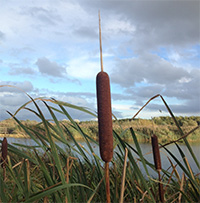Autumn
A season of variable weather but the days are getting cooler and there is a chance of frost at night.

Birds
Autumn brings a different group of visitors to the wetlands. Common Snipe come here to feed, their long beaks perfectly adapted to probing the wet grassy ground to find the worms and insects.
With numbers of Snipe falling across the country, particularly on lowland wet grassland, our meadows are extremely important, providing winter food and shelter for this shy wetland bird. The number builds up through the autumn as rain softens the ground so that they can feed.
The Meadow Pipit is another early winter arrival, small brown birds with white in the tail over the grassy areas whose cheep call is often heard even though the bird is out of sight.
Winter thrushes arrive before the onset of winter initially just one or two and then mixed flocks of Redwing and Fieldfare.
 Black-headed Gulls make the main pool their winter roost and leave copious traces of their presence on the boardwalk rails!
Black-headed Gulls make the main pool their winter roost and leave copious traces of their presence on the boardwalk rails!
In late November, as winter comes around, the skies above the reserve become the setting for one of nature's most spectacular displays. At sunset Common Starlings begin to gather in small flocks, wheeling and circling above the wetland. Over an hour or so, as the light fades, the flocks grow and coalesce into a swirling cloud of bodies that move as one, occasionally growing to encompass many thousands of individual birds.
Then it seems, at a sudden signal unseen by the watcher, the whole flock plunges into the reeds.
Once a common sight across the country, these murmurations of starlings are much reduced, so we are truly lucky to have one so close to home.
Hedgerows
 Our boundaries burst with colour at this time of year. Not only are the leaves changing colour, berries and fruits ripen and glisten, tempting people and wildlife alike to share in the bounty. Blackberries are everyone's favourite. Easy to identify, but not so easy to pick, they come with their own prickly protection, which is just as well as these sweet, fragrant berries don't last long as birds, people and small mammals all take their fill while they can.
Our boundaries burst with colour at this time of year. Not only are the leaves changing colour, berries and fruits ripen and glisten, tempting people and wildlife alike to share in the bounty. Blackberries are everyone's favourite. Easy to identify, but not so easy to pick, they come with their own prickly protection, which is just as well as these sweet, fragrant berries don't last long as birds, people and small mammals all take their fill while they can.
Hawthorn puts on a fiery display, with scarlet berries hanging in clusters, a tempting treat for wildlife, with blackbirds and starlings gobbling up the hawberries from the safety of the thorny bushes.
Rosehips and Guelder Rose add more fire with their red fruits. Rosehips are well known for their Vitamin C content and also beloved by youngsters as a source of itching powder. Guelder Rose berries hang in drooping clusters, with a translucent, glowing appearance that makes them seem almost unreal.
Sloes are the fruit of the Blackthorn and they have powerful protection. The thorns of Blackthorn are vicious long spikes, brittle and painful. Some people are allergic to the thorns so it's always best to take care.
Mammals
It's not just birds that are making the most of the hedgerow fruit. Mice and voles  will be eating their fill to build up their reserves to see them through the coming winter. As the vegetation dies down and the grass slows down its growth, you might be able to spot small tunnels and tiny trackways through the long, tussocky grass near the hedgerows.
will be eating their fill to build up their reserves to see them through the coming winter. As the vegetation dies down and the grass slows down its growth, you might be able to spot small tunnels and tiny trackways through the long, tussocky grass near the hedgerows.
Surveys have shown bats to be very active during this period as they build up reserves for the winter. Among the 8 species that have been recorded here so far the most frequently encountered are Common and Soprano Pipistrelle and Daubenton's Bat.
Hedgehogs will be looking for places to hibernate over winter. Piles of logs on higher ground or under a dense bush and of course, compost piles are attractive places to see out the winter. If you're lucky enough to have a hedgehog hibernating in your garden you can look forward to a bit of natural slug control when it wakes up.
Insects
If the weather is warm, dragonflies will continue to fly, particularly hawkers as will the butterfly species that were first to appear in the year. Butterflies might still be flying, looking for a warm, sheltered spot to overwinter.
Ladybirds and lacewings begin hibernating, hollow stems and sheltered bundles of sticks make ideal insect hotels. You can make your own quite easily and as both these insects feast on aphids throughout the spring and summer, they're a good friend to have around the garden.
